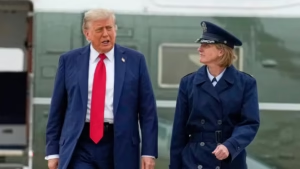INTRODUCTION

President Donald Trump has directed officials at U.S. Immigration and Customs Enforcement (ICE) to ramp up their operations aimed at detaining and deporting migrants in major urban areas led by Democratic leadership.
This directive represents a notable intensification of his administration’s efforts to combat illegal immigration, coinciding with a backdrop of significant public demonstrations opposing such stringent immigration policies.
The decision underscores the administration’s commitment to enforcing immigration laws more aggressively, particularly in cities that have adopted more lenient stances towards undocumented immigrants.
As protests continue to unfold across the nation, this escalation in enforcement actions is likely to further polarize the ongoing debate surrounding immigration reform and the treatment of migrants in the United States.
On the evening of June 15, former President Trump took to Truth Social to advocate for a dramatic escalation in deportation efforts, calling on Immigration and Customs Enforcement (ICE) officers to mobilize all available resources.
He characterized this initiative as an unprecedented mass deportation campaign, aiming to set a record in the history of immigration enforcement.
Trump’s post emphasized the urgency and importance of this initiative, urging ICE personnel to fully commit to the task at hand, thereby signaling a return to his administration’s hardline stance on immigration policy.
This call to action reflects his ongoing influence within the Republican Party and his continued focus on immigration as a pivotal issue in American politics.
Following significant protests triggered by ICE raids in Los Angeles last week, the governor issued an order to deploy the National Guard and Marines in an effort to restore order amidst the unrest.
The demonstrations, which began in response to the raids, quickly escalated and spread to various cities nationwide during the “No Kings” rallies held on June 14.
These events highlighted widespread discontent and mobilized communities across the country, prompting a decisive governmental response to address the escalating tensions and ensure public safety.
To fulfill his objectives regarding deportation, Trump emphasized the necessity of intensifying efforts to detain and remove undocumented immigrants from some of the largest urban centers in the United States.
He specifically pointed to cities like Los Angeles, Chicago, and New York, highlighting that these metropolitan areas are home to millions of undocumented individuals.
This approach underscores a strategic focus on high-density locations where the presence of illegal immigrants is particularly significant, suggesting that targeted actions in these cities could lead to more effective enforcement of immigration laws.
The cities in question represent the epicenter of Democratic influence, where the strategic use of undocumented immigrants is perceived as a means to bolster their electoral support.
This approach is often criticized as a tactic to manipulate election outcomes and to expand the welfare system, which some argue detracts from the opportunities available to hardworking American citizens.
Critics contend that this practice not only undermines the integrity of the electoral process but also leads to the erosion of well-paying jobs and benefits that should rightfully belong to those who have contributed to the economy through their labor.
The implications of these actions raise significant concerns about fairness and equity in the job market and the broader societal impact on American workers.
Former President Trump expressed his desire for Immigration and Customs Enforcement (ICE) officers to concentrate their efforts on areas plagued by high crime rates and violence, particularly in urban centers.
He specifically pointed to the significant influence of Sanctuary Cities in these regions, suggesting that they contribute to the challenges faced by law enforcement.
Trump emphasized that discussions surrounding Sanctuary Cities are notably absent in the Heartland of America, implying that the issues they create are more pronounced in certain urban locales rather than in the more rural or suburban areas of the country.
read more : How Much Is Gold Per Ounce In USA 2025 ?